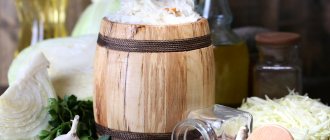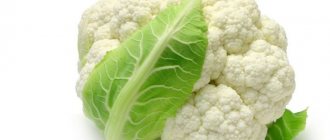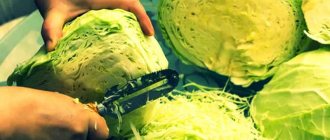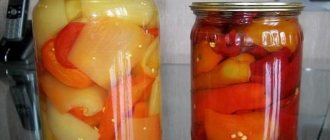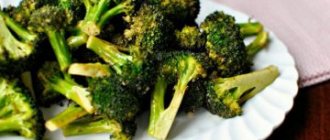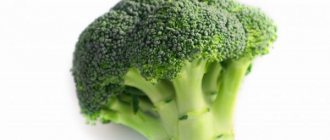Which cabbage varieties are best suited for drying?
Any cabbage is suitable for drying , but when choosing, you need to start from what dishes it will be added to:
- The most popular option is preparing white cabbage for making soups. For this purpose, it is better to select those varieties that are harvested in early autumn.
- The second most popular is cauliflower - it is added to vegetable stews, and sometimes eaten instead of chips.
- Next comes broccoli for soups and instead of seasoning, and in last place are kohlrabi and Brussels sprouts.
The popularity of a particular type depends to a large extent on the prevalence of a particular cabbage in gardens and on shelves, as well as on their cost. Cheaper cabbage is more popular and vice versa. The breadth of use of dried vegetables also plays a role: there are much more recipes with white cabbage than with kohlrabi.
Basic Rules
What varieties of cabbage are best suited for drying? Any cabbage is suitable for drying, but when choosing, you need to start from what dishes it will be added to.
The most popular option is preparing white cabbage for making soups.
For this purpose, it is better to select those varieties that are harvested in early autumn. The second most popular is cauliflower - it is added to vegetable stews, and sometimes eaten instead of chips (read about where and how to keep cauliflower fresh longer for the winter at home). Next comes broccoli for soups and instead of seasoning, and in last place are kohlrabi and Brussels sprouts .
The popularity of a particular type depends to a large extent on the prevalence of a particular cabbage in gardens and on shelves, as well as on their cost. Cheaper cabbage is more popular and vice versa. The breadth of use of dried vegetables also plays a role: there are many more recipes with white cabbage than with kohlrabi (read about the varieties, harvesting and storage of kohlrabi here).
How to prepare cabbage for drying? The main rule for dehydrating cabbage is that it should not have rotten, spoiled areas . So before drying, all raw materials must be sorted out and separated from what will not be used: for cabbage, Brussels sprouts, cauliflower and kohlrabi, these are the outer green leaves.
In addition, in cauliflower and broccoli, it is necessary to cut off the inflorescences from the stem and stalk . Next, wash all the cabbage (for white cabbage you can skip this step) and start cutting and drying.
What to dry cabbage in? Is it possible to dry cabbage in a dryer? Cabbage is usually not dried in the sun, so there are two options left:
- Baking tray in the oven.
- Electric dryer tray.
The dryer is designed so that nothing sticks and is easy to clean. But the baking sheet from the oven should be greased with vegetable oil or, even better, lined with baking paper .
silicone mats have appeared on sale , and they can also be used in the oven. Usually pies and pizza are cooked on them at a temperature of about 250 degrees, so nothing will happen to them when drying vegetables for a long time. Nothing sticks to this mat, and you don’t have to wash the baking sheet after using it.
At what temperature should you dry cabbage? The optimal temperature for drying cabbage is 45-80 degrees . At the same time, you don’t have to worry about it burning during preparation. Such low and precise temperature conditions can only be set in industrial conditions or on an electric dryer for home use.
On some slabs the minimum value is 50 degrees, while on others it is 100.
If you send cabbage to dry in the oven at a temperature above 120 degrees , the vegetables will fry, but will not dry out.
So for the oven you should choose a range from 50 to 100 degrees .
Another important condition for drying is to allow excess moisture to escape. The dryer does this automatically, but on the stove you will need the “convection” mode . If it is not there, then you can clamp a wooden pencil between the door and the oven.
It will not burn during the process, but will allow you to keep the oven slightly open , which will ensure that moist air escapes out. If this is not done, the cabbage may begin to stew rather than dry out.
How to determine readiness ? Cooked vegetables lose significant size. They also change color, which is especially noticeable in light-colored types of cabbage - it becomes a little yellowish . If you press hard on a dried piece, it will not release the juice.
At the same time, the cabbage should not crumble when it is picked up - this indicates that the vegetable is overdried . It can still be used for food, but over time it will turn into dust and will only give off its aroma to the dish.
Composition and calorie content of dried cabbage
100 grams of freeze-dried white cabbage is the equivalent of a whole kilogram of fresh vegetable . The same 100 g of dried product has a calorie content of 278 kcal, while the calorie content of 100 g of fresh cabbage is only 28 kcal. All the nutrients that a fresh vegetable has are present in its dried version in concentrated form.
Moreover, a product dried at low temperatures better retains all useful substances than a fresh vegetable stored for a long time . That is, in the spring, freeze-dried cabbage is much healthier than fresh cabbage that has been lying in the vegetable store all winter.
This is interesting! In the annual vegetable diet of modern man, cabbage takes up 25%.
Dried cabbage retains a high content of ascorbic acid (vitamin C), as well as the presence of :
- retinol (vitamin A);
- thiamine (B1);
- riboflavin (B2);
- choline (B4);
- pyridoxine (B6);
- folic acid (B9);
- tocopherol (E);
- menadione (K);
- nicotinamide (PP);
- methionine (U).
High saturation of this product:
- potassium;
- magnesium;
- phosphorus;
- copper;
- iodine;
- iron;
- sodium;
- gray;
- chlorine
Reference! This vegetable also contains pectins, carotene and 16 free amino acids.
The energy value of dried cabbage is determined by the presence of 100 g of product:
- 16 g proteins;
- 1.5 g fat;
- 47 g carbohydrates.
Benefits of drying
Products can be preserved in a variety of forms: salted, boiled, pickled. However, with these processing methods, some vitamins are lost. Therefore, drying vegetables is the optimal option for storing vegetables for the winter from the point of view of preserving vitamins, since with this method of heat treatment, cabbage does not lose its properties, 97% of all available vitamins are preserved. Drying in an electric dryer preserves not only vitamins, but also most micro and macroelements, as well as all the taste, color, and aroma of products. They can be easily stored for years and take up little space.
Dried white cabbage is a product that is obtained from ordinary fresh cabbage by chopping and sublimating its leaves. This product is excellent for preparing various first and second courses and comes in higher quality (first grade) and second grade (calorizer). An indicator of the quality of a product is the percentage of moisture content in it (14%). 100 grams of dried cabbage contains 48 grams of carbohydrates, 15 grams of proteins, 1.4 grams of fat. Nutritional value is 278 kcal. White cabbage is rich in essential vitamins and when dried, almost all of them are preserved. It contains a lot of vitamin C, vitamins B, E, carotene, vitamin H, PP. Cabbage is rich in magnesium, potassium, and phosphorus.
The benefits of dried cabbage for the body
The dried product practically does not provoke allergic reactions , is well digestible and is excellent for preparing dietary dishes.
This vegetable really helps in treating :
- cardiovascular diseases;
- diabetes mellitus;
- hemorrhoids;
- stomach ulcer;
- liver diseases;
- constipation;
- obesity;
- atherosclerosis;
- gout;
- gallstone disease.
The presence of tartonic acid in the product makes it possible to significantly slow down the process of converting carbohydrates into body fat . The presence of folic acid stimulates cell regeneration processes, increases their oxygen saturation, which leads to a noticeable improvement in the condition of the skin and hair.
In addition, the product’s ability to normalize monthly cycles and optimize girls’ puberty is relevant for women.
The increased tendency of the gastrointestinal tract of infants to form gas requires them to refrain from consuming this vegetable until they are one and a half years old.
But then cabbage becomes an indispensable ingredient in many children's dishes . The year-round availability of dried cabbage, the abundance of useful substances in it, its good digestibility by the child’s body, and its pleasant taste make it a popular product for baby food.
is equally valuable for older people , who often suffer from all kinds of inflammatory processes, metabolic disorders and constipation.
The constant presence of the vegetable in question in their menu strengthens the immune system and rids the body of bad cholesterol, improving the functioning of the circulatory system.
This is interesting! Over the course of a day, a head of cabbage absorbs and evaporates as much moisture as a horse drinks in the same period.
Which cabbage to choose for drying?
To prepare a healthy semi-finished product, you should choose the cabbage that is most preferred in your family. The preparation can be used in the future for first and second courses, various fillings and side dishes. The most common varieties for drying:
- White cabbage. When dried, it retains up to 97% of valuable substances. It is best to harvest a late harvest. The heads of cabbage should be firm, white and fully ripe.
- Savoy. Cultivated in abundance in European countries. Contains 2 times more vitamins and minerals than the white variety. Suitable for frying, making soups, salads and fillings.
- Brussels. Cabbage heads have a diameter of up to 5 cm and a dense texture. The taste is sweetish and unique. The composition contains a large amount of protein, so Brussels sprouts broth is not inferior to chicken broth.
- Colored. It is easily absorbed by the body and contains an optimal set of nutritional components. In dried form, cabbage can be used to prepare dietary dishes.
- Broccoli. High-quality broccoli has a bright and rich green color, and the inflorescences fit tightly together.
Cabbage with damaged or frozen leaves is unsuitable for drying. The smell should be absent or fresh and characteristic. To save money, vegetables should be dried during the season. From September to November the lowest prices are for white cabbage, from October to March - for Brussels sprouts, and from October to December - for cauliflower. It is recommended to buy only ripe vegetables. They store better and have a rich taste.
How much dried cabbage can you eat per day?
As already mentioned, a freeze-dried product is 10 times higher than a fresh vegetable in terms of the concentration of nutrients in it. And if doctors do not recommend eating more than 200 g of fresh cabbage per day , then, logically, you should not consume more than 20 g of dried cabbage per day.
Limiting the amount of fresh vegetables eaten during the day is caused by its ability to provoke bloating. And in this sense, comparing it with a freeze-dried product is not entirely correct.
If you can make salads from fresh cabbage or simply eat cabbage leaves, then the dried vegetable is used exclusively for cooking :
- borscht;
- cabbage soup;
- vegetable soup;
- pickle;
- vegetable stew;
- side dishes;
- various cereals (as an additional ingredient), etc.
In this form, the use of the vegetable is limited only by the degree of saturation of a person.
Benefit or harm?
Few people know, but dried cabbage is much healthier than fresh vegetables , which have been in the refrigerator or in grocery warehouses for several days. By drying a vegetable at a low temperature, you can preserve all the vitamins and microelements present in it, which disappear during long-term storage fresh.
The dried product also has a positive effect on the financial condition of the family, because you can begin the process of drying the plant during the seasonal cabbage harvest, when it is sold at a low price.
Its only drawback is the increased calorie content.
Approximately 10 times more than fresh cabbage. That is why the presented ingredient should be consumed in minimal quantities, then the risk of rapid weight gain is reduced.
At this point, you need to take into account the cabbage variety itself, since each variety has its own calorie content:
- Brussels - 430 kcal per 100 g;
- Colored – 250 kcal per 100 g;
- Kohlrabi – 270 kcal per 100 g;
- Broccoli – 340 kcal per 100 g;
- White cabbage – 278 kcal per 100 g.
An interesting fact is that the higher the calorie content of a vegetable, the more vitamins, macro- and microelements it contains.
Possible contraindications and harm of dried cabbage
The restrictions associated with the consumption of fresh white cabbage are caused by its ability:
- cause severe bloating; bring heaviness in the stomach and nausea;
- worsen thyroid problems;
- aggravate the course of the disease with enteritis, colitis, gastritis with high acidity, inflammation of the duodenum.
The freeze-dried product, which is almost always consumed in heat-treated form, has no such contraindications and can be consumed within reasonable limits almost always and by everyone, with the exception of rare cases associated with individual intolerance to the product.
How to prepare cabbage for drying
The main rule for dehydrating cabbage is that it should not have rotten, spoiled areas .
This is interesting: Recipes from experienced housewives: marinated cabbage with horseradish in jars for the winter
So before drying, all raw materials must be sorted out and separated from what will not be used : for cabbage, Brussels sprouts, cauliflower and kohlrabi, these are the outer green leaves. In addition, cauliflower and broccoli need to cut off the inflorescences from the stem and stalk.
Next, wash all the cabbage (for white cabbage you can skip this step) and start cutting and drying.
Storing broccoli (methods)
Everyone who grows it in their garden knows how to store broccoli. There are more and more broccoli lovers. Because the vegetable is tasty and healthy for the body. But the trouble is that it quickly deteriorates, but there are ways to preserve it longer. And further, in our article we will tell you about all the available methods. Go?
How to store broccoli in the cellar/basement
Storing broccoli in a cellar or basement will be especially convenient for owners of private houses. And especially, cellars are good if a huge harvest has been harvested and the cabbage needs to be put somewhere. But it’s impossible to eat everything. There is a lot of space in the cellar, and this is a big plus.
First, the storage must be disinfected with any antifungal agents, for example, copper sulfate or disinfectin.
Next, we wrap the heads in thick paper and place them on shelves. Here, we watch the paper and change it as it gets wet.
On a note!
If possible, you can leave the outer leaves at the head, and then it is believed that the cabbage will be stored better. And if the leaves begin to rot, then we remove them or you can also shorten the petiole.
How to store broccoli and for how long depends on the storage conditions. Therefore, we strive to maintain optimal conditions. And if they are followed, broccoli can be preserved for 1 - 2 months. Note that it is possible longer, but then there is a loss of taste and beneficial qualities. Do we need this?
How to store broccoli in an apartment
I think everyone who grows it would like to know how to store broccoli in an apartment. But storing it is not easy, because cabbage spoils quickly. Without a refrigerator, it can last a couple of days, no more. In addition, it loses its taste and beneficial properties, and they become 2 times worse. Important
. The cabbage needs to be refrigerated as quickly as possible; there is no time to hesitate. Further in the article, we will consider all the available methods. Go?
In a refrigerator
Broccoli can only be stored for 7 - 10 days.
Here, we place each head individually in a plastic bag with ventilation holes for air access and place it in the vegetable compartment. Important
. For longer preservation, it is better not to wash the cabbage.
On a note!
Ethylene has an adverse effect on broccoli heads. When exposed to it, the inflorescences will ripen and therefore will be unsuitable for food. Typically, apples, pears, plums, bananas, peaches and kiwis emit ethylene. Therefore, these fruits should not be next to broccoli.
Store like flowers
.
Here, we take a vessel so that it is smaller in diameter than the head and pour 2 - 3 cm of water into it, and place the head in it so that the petiole is in the water. Cover the top loosely with a plastic bag. In this way, you can store cabbage for up to 5 days. Important
. At the same time, the water in the bowl needs to be changed every day. With this method, you can extend the shelf life even at room conditions.
Alternatively, you can wrap the cabbage in a waffle towel. Here, it's important
so that it is moist. This way you can store the heads for 3 - 4 days.
And yet, you can wrap the broccoli heads in foil (tightly), and then you can keep the heads fresh for 1 month. But, in any case, you need to check the vegetables periodically.
In the freezer
You can store broccoli for a year. Here, we disassemble into inflorescences, fill with salted water (1 tbsp per 1 liter of water), blanch for 2 - 3 minutes, dry and arrange into portioned bags. Next, we shove it into the freezer. All.
How to dry white cabbage to preserve vitamins
Since the described vegetable is not dried in the sun, there are several proven methods for sublimating it at home :
- on a baking sheet in the oven;
- in an electric dryer;
- in a convection oven;
- using a microwave.
All methods are equivalent in terms of results, but differ in the ease of implementation of the process . The electric dryer tray does not require preliminary preparation, since the dried vegetable does not stick to it, and after completing the procedure it is easy to wash. The baking tray in the oven must be greased with vegetable oil or covered with baking paper.
Important! At temperatures exceeding +120°C, the cabbage will begin to fry rather than dry out.
In all cases, the temperature at which the vegetable is sublimated is of paramount importance. In order for the dried product to retain the maximum of the nutrients it contains, the process must take place at a temperature from +45°C to +80°C .
For the sublimation process to proceed correctly, the heating device must have an outlet for evaporated moisture . In an electric dryer, this is provided for by the design features, and for an oven it is necessary to either set the “Convection” mode, or, in its absence, leave a gap using, for example, a pencil inserted between the oven body and the oven lid. If this is not done, the vegetable will stew instead of drying out.
The readiness of the product is determined by its greatly reduced mass and yellowish tint . When pressed firmly with your fingers, the dried cabbage piece should not release any juice.
If it breaks, it means the product is overdried. It can be used for food, but during storage it can turn into a powder, which, apart from the smell, will contain little benefit.
Let's take a closer look at each of them.
How to dry in the oven
This method is considered artificial . It gained its popularity due to the widespread use of household ovens. It is rare that a kitchen is not equipped with one.
The cabbage will have to be dried in several stages, otherwise the vegetable will be hopelessly overdried or burnt. The door will have to be kept open. The desired result can be achieved in 2–3 days.
The cabbage is cut into thin strips and blanched . Excess moisture should drain completely. The temperature is set from 50°C to 100°C, but not higher. If the oven does not have a convection function, the door will have to be opened slightly and held in this state using a regular pencil.
When it turns yellowish and the juice stops flowing out, you can remove it..
Advice! To dry vegetables, it is better to use an electric oven.
In an electric dryer
In this case, the pieces of vegetables are heated evenly on all sides . The process takes several hours. The device is compact, so it will fit even in a small kitchen. The optimal temperature is considered to be within + 40-60°C. You should not exceed it.
The raw materials are prepared in the same way as for the oven . But the process will take much longer, since the temperature in the electric dryer will be half lower. Shredded cabbage is laid out on each tier. It will dry in about 6 hours.
In the microwave
Vegetables are cut into thin slices. They dry out quite quickly. Only a lot of cabbage won’t fit in the oven.
The thickness of the pieces should not exceed 2–3 cm . It is to this depth that ultrahigh frequency radiation penetrates. The water molecules are set in motion and the moisture gradually evaporates.
Note! Models that allow food to rotate on the plate are more effective.
In a convection oven
Wash the vegetables, cut them and treat with boiling water . Place on paper towels to absorb excess moisture. Then put it on the steamer and place it on the top rack. Temperature within 60-65°C.
Note! A small portion will be ready in 15 minutes, a larger portion in half an hour.
Optimal storage conditions
The question “how to store broccoli” is always resolved if optimal storage conditions are observed. Here, the temperature should be + 0 ° C - 6 ° C, and the humidity can be kept at 80% - 90%.
Good ventilation and the absence of temperature changes contribute to the storage of cabbage, because changes cause condensation, which contributes to spoilage.
Features of drying broccoli and other types of cabbage
This type of cabbage is quite difficult to store fresh at home, so broccoli is often frozen or dried for the winter .
Broccoli can be dried either whole or finely chopped . It is most convenient to do this in a special dryer for vegetables and fruits, but if you don’t have one, you can also turn to the oven. The process itself is not much different from drying white cabbage, but this type requires much more time.
Advice! To reduce it at least slightly, you can cut the inflorescences into halves.
Since drying vegetables in the oven consumes a lot of electricity, if you do such preparations frequently, it makes sense to purchase an electric dryer , which is more economical.
Drying broccoli and cauliflower in the oven
For drying broccoli and cauliflower in the oven, there is the following recipe:
- The forks are divided into inflorescences , which are then thoroughly washed and placed in salted water for 5 minutes.
- Place a pan of water on the stove and after the liquid boils, throw in the prepared inflorescences. Blanch the cabbage in this way for 3-5 minutes, remove from heat and drain the water.
- Place the cabbage on a towel and allow to dry for at least 1 hour to allow the water to drain after cooking.
- the oven temperature to 50-100 degrees, let it warm up and place the baking sheet with the prepared cabbage there for 3-5 hours.
Note! Since broccoli and cauliflower have thick stems, drying can take up to 5 hours. At the same time, the cabbage should not be left unattended and, at least once every half hour, it must be turned over and checked so that it does not burn.
The drying process will go faster if the inflorescences are cut into thin slices . This is done after blanching in hot water. And during drying, it is extremely important that the inflorescences do not obscure each other and lie in one layer.
If the oven has a convection mode, then it must be turned on , and if it does not, then the door must be kept slightly open.
How to dry Brussels sprouts and kohlrabi in the oven
The process is slightly different for these species:
- The outer spoiled and dirty leaves are separated from the head of cabbage
- The cabbage is chopped and placed in boiling water for 3 minutes.
- Then the vegetables are left to dry a little for half an hour or an hour.
- Place the dried cabbage
This is interesting: Sauerkraut with apples for the winter recipes: how to prepare a very tasty appetizer
Dry the shredded cabbage for 2-3 hours , not forgetting about the convection mode or the door ajar.
How to dry broccoli and cauliflower in an electric dryer
The preparation process for drying these types of cabbage in an electric dryer is entirely the same as for the oven. But the process may take much longer, because with this method, if it is possible to use a lower temperature, which is preferable to do .
Note! At a temperature of 60 degrees, the process can take up to 6 hours. In this case, the lower tiers are usually ready earlier than the upper ones.
Since these types of cabbage contain a lot of moisture, once every hour and a half you need to check if anything is burning , and it is also recommended to rearrange the tiers so that everything dries evenly.
How to dry Brussels sprouts and kohlrabi in an electric dryer
The preparation here is similar to the oven method, and the drying process itself is the same as for broccoli .
The only difference will be the time. Finely chopped vegetables will be ready in 3-4 hours, but you should keep an eye on them.
Features for broccoli
This type of cabbage is quite difficult to store fresh at home, so broccoli is often frozen or dried for the winter.
How to prepare dried broccoli for the winter? Broccoli can be dried whole or finely chopped.
It is most convenient to do this in a special dryer for vegetables and fruits, but if you don’t have one, you can also turn to the oven .
The process itself is not very different from drying white cabbage, but this type requires much more time (storing white cabbage is described here).
To reduce it at least slightly, you can cut the inflorescences into halves. Since drying vegetables in the oven consumes a lot of electricity, if you do such preparations frequently, it makes sense to purchase an electric dryer, which is more economical.
Recommendations for drying cabbage
In order to qualitatively sublimate white cabbage in an electric dryer or in an oven, you need to choose mid-late or late cabbage varieties , which are distinguished by stronger and juicier forks. They are cleared of the outer leaves and chopped into thin chips.
Important! For drying, you should not use cabbage of early varieties, as well as frozen heads of cabbage with musty odors.
Before the sublimation process, the chopped vegetable is placed in boiling water for 3 minutes , after which it is dried at room temperature for an hour. Then it is laid out in one layer on a tray or baking sheet and placed in a preheated oven or electric dryer, which is then turned on.
The drying process takes at least 2 hours and lasts, depending on the temperature, the longer it is, the lower it is.
Broccoli varieties for storage
Broccoli, like any other crop, varies in terms of ripening. And here, early varieties (90 - 100 days) have looser heads, and accordingly they are stored worse than late varieties. Such varieties can only be stored for 2 weeks (no more). The best early varieties
: Batavia, Linda, Lord, Tonus, Blue Spindle.
For longer storage, only middle or late (135-145 days) varieties and hybrids are suitable. Such varieties are usually more resistant to various diseases, as well as to unfavorable conditions (drought, temperature changes). Under optimal cold conditions, storage is possible for 2 - 3 months. These varieties include: Agassi, Marathon, Gnome, Fortuna.
Read more about broccoli on our website here in the article.
Storing and using dried cabbage
Store dried vegetables in glass jars, plastic containers or, best of all, in cotton fabric bags .
very important that such blanks can “breathe”, but do not become damp or become moldy . The last problem arises if the vegetables are not completely dried, so if the housewife has any doubts, they can be dried again in the oven or in the dryer for half an hour or an hour.
Closed containers must sometimes be taken out and the contents allowed to ventilate a little . This check is done once every 2-3 months.
Note! With proper drying and proper storage, cabbage can be stored for up to two years, and it will come in handy not only in the home kitchen, but also during camping and travel.
Dried vegetables, including cabbage, are simply the most ideal foods for camping and an excellent option for preparing multi-ingredient dishes at home when you are short on time. They do not spoil for many months, take up little space, are packaged in plastic containers and weigh very little.
After drying, vegetables become richer in taste and aromatic due to the evaporation of water . That is, a mixture of dried vegetables is an ideal aid for a tourist.
By using a wide variety of dried vegetables, you can fully experience their harmonious taste, wonderful aroma and enjoy an excellent dish.
How can you use dried cabbage?
Vegetables are a real storehouse of vitamins that are simply necessary for humans. Moreover, they can be used fresh or dried. Garlic, herbs, cabbage, potatoes, carrots, and beets are mainly dried as preparation for the winter. The use of dried vegetables most often comes down to making various types of soups, pickles, and borscht. However, many housewives add them when making cutlets and even some porridges.
Dried vegetables will become indispensable not only in everyday life, when there is a need to quickly prepare some multi-component complex dish, but also on various trips. After all, tourists usually take only the essentials (tents, sleeping bags, gear), the weight of the backpack is calculated literally to the gram, and you need to take a decent amount of things. For food, preference is given mainly to cereals and canned food. There is no room left for such delights as potatoes, carrots and onions. Dried vegetables take up little space in your backpack, but at the same time allow you to cook excellent rich soups, pickles, cabbage soup and borscht over the fire. That is why they are perfect for tourists. A small amount of dry vegetable mixture can make a complete lunch or dinner for a large group of travelers. All you need to do is restore the water balance of the food by soaking it in water, and then cook the first or second course over the fire. You can add vegetables not only to soups, but also to various cereals. Barley, buckwheat, rice with vegetables cooked over a fire are complete and nutritious food that a tourist needs to restore his strength. When making a list of necessary products for a hike, dried vegetables should definitely be included in it. All you need to do is cook any cereal suitable for meat porridge in boiling water in a pot over a fire until half cooked, add pre-soaked dry vegetables to it and continue cooking. After 10 minutes, add canned meat and seasonings. The result is an excellent, nutritious dish, rich in the aromas of fire, meat and vegetables, which will not leave anyone indifferent. If dried meat is used, it should be added along with the vegetable mixture.
Popular recipes using dried cabbage
The dried vegetable is used to prepare a wide variety of dishes.
Vegetable stew
Most often, dried cabbage is used together with other vegetables such as zucchini, onions, tomatoes, herbs, and potatoes.
Before cooking, they should be soaked for half an hour in water to restore them. Then place in a colander to drain the liquid and fry in vegetable oil for 10 minutes.
Add any broth (vegetable, mushroom, chicken, beef, pork) and simmer until fully cooked, not forgetting to season with spices.
Borsch
Of course, you can’t do without dried cabbage when preparing borscht. To do this, add dried potatoes, onions, carrots, beets, dill and parsley.
All products are boiled for about 25 minutes in water, then taken out and fried a little in vegetable oil , dipped back into the broth and simmered over low heat for about 15 minutes. If you want something spicier, then you can also add small capsicum and pepper to the mixture of dried vegetables – peas and bay leaf.
Advice! You can add a little dried horseradish root. In this case, the borscht will have a very pleasant and appetite-stimulating spicy smell.
Cabbage soup
Dried cabbage is indispensable for preparing ordinary cabbage soup. In this case, a mixture of dried vegetables (cabbage, potatoes, onions, parsley and dill, carrots) is boiled in any broth for about half an hour until fully cooked. You can do the following. Soak all the ingredients for 10 minutes , then drain them in a colander, let the liquid drain and fry the vegetable mixture in a frying pan with vegetable oil. Boil the broth and put the overcooked mixture into it. Add spices to taste and simmer the cabbage soup over low heat for another half hour.
Advice! For variety, you can add dried bell peppers, dried tomatoes, various herbs and roots to the cabbage soup. Dried forest mushrooms add an amazing aroma to the soup.
Kefir soup
Another original soup made from dried vegetables using dried cabbage is kefir. To prepare it, place dried white cabbage, dried carrots, dried onions and dill in a liter of boiling water , bring to readiness, add pepper and salt, and cool.
Next, add 0.5 liters of kefir and several fresh cucumbers cut into strips to the vegetable mixture . The dish is sprinkled with dill and served with sour cream.
Advice! The refreshing taste and wonderful aroma of this unusual soup is perfect for a hot summer day.
Where to apply?
Such preparations can easily be used as additives in soup or other dishes, pies. This is explained by the fact that the taste of kaputa does not change, only the amount of moisture it contains decreases.
If you want to make a pie or pies with cabbage (where this product will be the key ingredient), you should soak the prepared dried product overnight, and then use it in the same way as the fresh version .
This preparation will be an excellent addition to vegetable stews, roasts, stews and soups (especially borscht).
Making borscht from dried vegetables:
